Overview
The article “How to Communicate Data Effectively: A Step-by-Step Guide” captures attention by outlining essential strategies and techniques for effective data communication. It builds interest by emphasizing the mastery of key components of data transmission—sender, message, medium, and receiver. By utilizing appropriate tools and storytelling techniques, organizations can enhance clarity and engagement. This ultimately generates desire for improved decision-making and operational efficiency. In conclusion, implementing these strategies is crucial for any organization aiming to excel in data communication.
Introduction
In an era where data reigns supreme, the ability to communicate insights effectively is critical. Organizations increasingly recognize that successful data communication transcends mere transmission; it requires crafting narratives that resonate with diverse audiences, leveraging appropriate tools, and employing best practices to ensure clarity and engagement.
Understanding the fundamental components of data communication and mastering advanced visualization techniques present opportunities to enhance decision-making and foster collaboration. As businesses navigate the complexities of the digital landscape, tailoring messages, avoiding common pitfalls, and committing to continuous improvement in communication skills become paramount.
This article delves into the essentials of effective data communication, exploring strategies and tools that empower organizations to transform raw data into actionable insights, ultimately driving growth and innovation.
Understanding the Basics of Data Communication
Data transmission involves the transfer of information between devices or systems, a fundamental process for effective communication. It comprises several key components: the sender, the message, the medium, and the receiver. Each element is vital in ensuring seamless interaction. The sender initiates the process by transmitting a message through a selected medium—be it wired connections, wireless signals, or other technologies—to the receiver, who then interprets the information.
Understanding these components is essential for mastering information exchange across diverse contexts, from formal reports to dynamic presentations. Recent statistics reveal that 98% of organizations now report privacy metrics to their board of directors, underscoring a heightened focus on information integrity and security in communication practices. Additionally, a significant 70% of business experts have noted considerable benefits from privacy initiatives, which not only reduce sales delays but also enhance operational efficiency and foster innovation.
This case study illustrates that effective privacy management cultivates customer trust and aligns with organizational objectives.
In the rapidly evolving AI landscape, employing Robotic Process Automation (RPA) from Creatum GmbH can significantly streamline manual workflows, thereby boosting operational efficiency. By automating repetitive tasks, organizations can reallocate valuable resources toward more strategic initiatives. Moreover, tailored AI solutions, including Small Language Models for effective information analysis and GenAI Workshops for practical training, can help navigate the complexities of management, addressing challenges such as quality deficiencies and governance issues.
This approach is crucial for generating insights based on information and enhancing decision-making capabilities.
Expert opinions emphasize the importance of these fundamentals; effective information exchange transcends mere detail conveyance, ensuring that the message is accurately received and understood. As Pew highlights, 63% of Americans confess to knowing very little, if anything, about the laws and regulations currently in place to protect their privacy. This underscores the necessity for organizations to communicate not only information but also the context and regulations surrounding it.
As technology advances, staying abreast of current trends in information-sharing methods becomes increasingly critical. The emergence of automated systems and artificial intelligence is reshaping how information is communicated, making it imperative for organizations to adapt and refine their strategies. Workshops focused on Generative AI (GenAI) can provide practical training, equipping teams with the skills necessary to leverage these technologies effectively.
In conclusion, a robust understanding of the dynamics between sender, message, medium, and receiver is vital for effective information exchange. This comprehension not only facilitates clearer communication but also supports the broader objectives of operational efficiency and strategic decision-making, ultimately driving business growth.
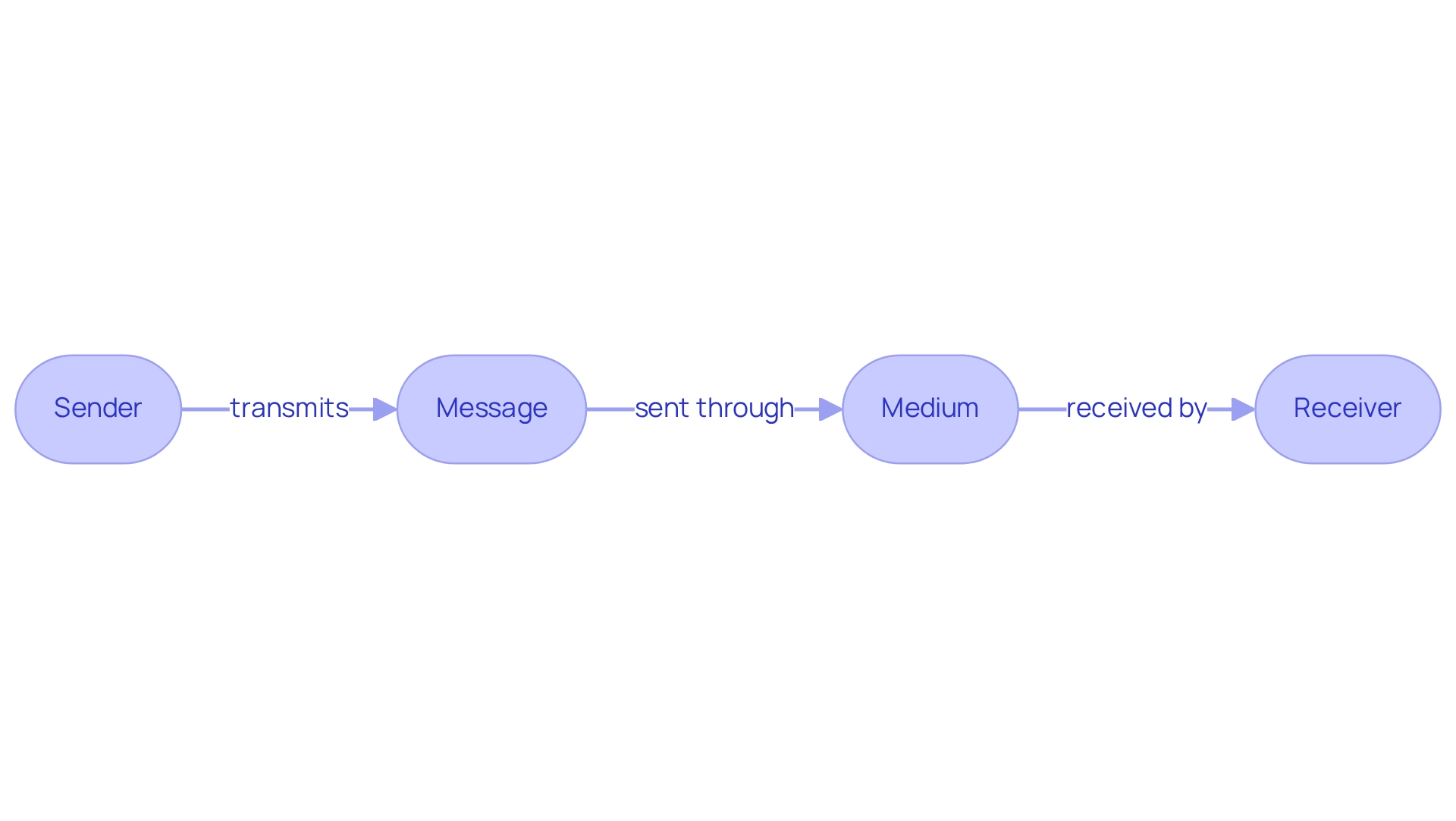
The Importance of Effective Data Communication
Effective information exchange is essential for organizations, guaranteeing that insights obtained from information can communicate data clearly and convincingly. When information is communicated effectively, it enhances understanding, facilitates informed decision-making, and fosters collaboration among stakeholders. In contrast, inadequate information exchange can lead to misunderstandings and misinterpretations, ultimately resulting in detrimental business decisions.
For instance, a case study on ensuring information security and privacy highlights how organizations that implemented robust security measures not only protected customer rights but also maintained transparency in information usage. This approach improves trust and decision-making processes.
In today’s rapidly evolving AI landscape, navigating the overwhelming options can be daunting. However, entities that emphasize efficient information exchange and utilize customized AI solutions can convert raw information into practical insights. This capability is crucial for driving growth and innovation.
Statistics show that organizations prioritizing efficient information exchange experience substantial enhancements in collaboration, with studies indicating a 25% rise in team productivity. This underscores the significance of mastering the craft of information exchange to communicate data effectively for anyone aiming to leverage insights for strategic benefit. Thought leaders, such as Randy Bean, CEO and managing partner of NewVantage Partners, stress that “large information sets are already being utilized to enhance operational efficiency,” reinforcing the need for clear interaction channels.
Furthermore, the transformative effect of Creatum’s Power BI Sprint is evident in client testimonials. For example, Sascha Rudloff, Team Leader of IT and Process Management at PALFINGER Tail Lifts GMBH, remarked on a notable increase in their Power BI development and an enhancement to their analysis strategy. As the information landscape continues to change, organizations must embrace successful interaction strategies to effectively communicate data, manage complexities, and promote informed decision-making. By prioritizing effective information exchange and leveraging Business Intelligence, organizations can unlock the full potential of their insights, ultimately leading to enhanced outcomes and sustained growth.
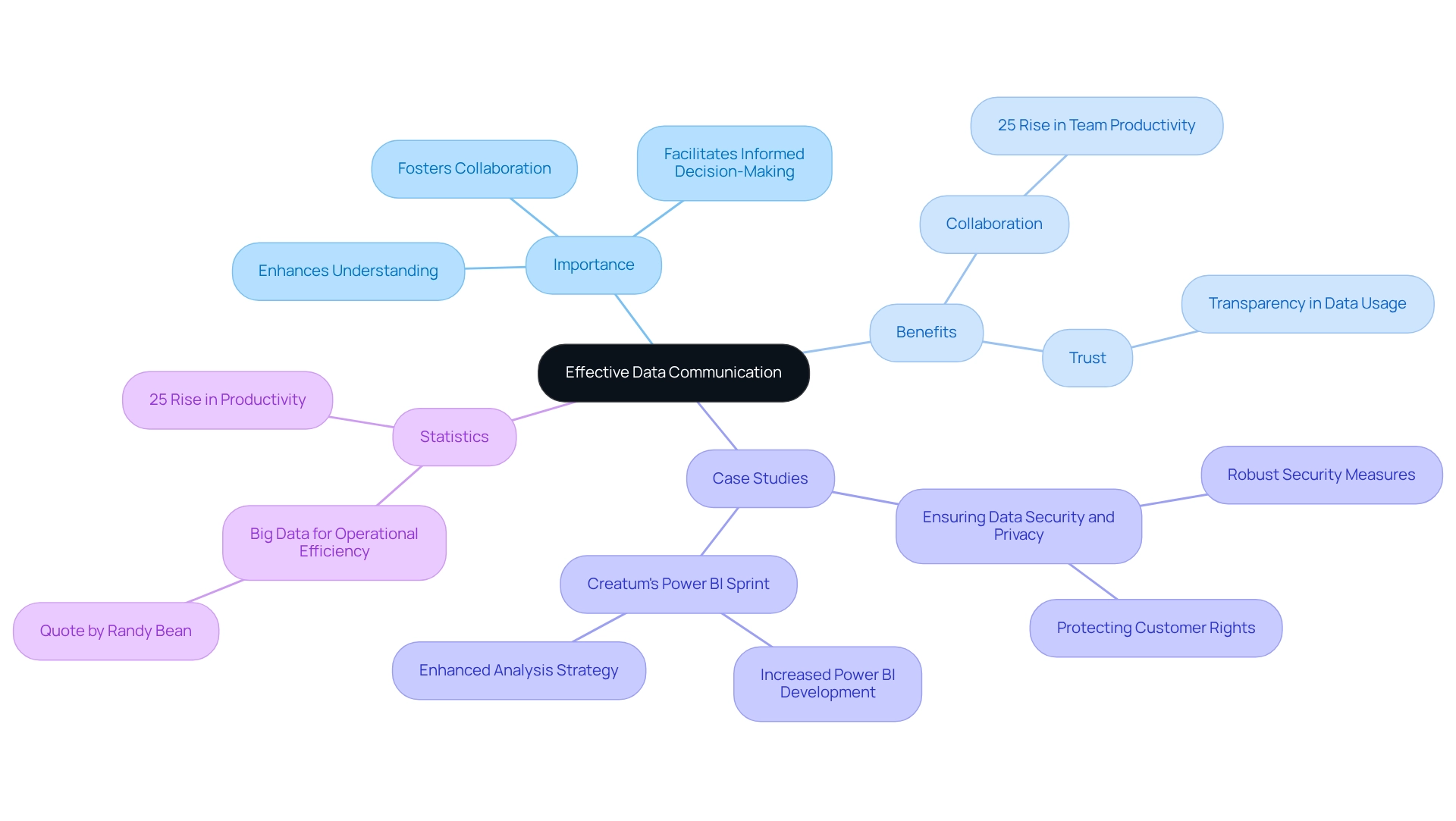
Tools and Techniques for Communicating Data
Efficient information communication hinges on a variety of tools and methods designed to enhance clarity and engagement, ultimately facilitating effective data communication. Among the most prominent visualization tools are:
- Tableau
- Microsoft Power BI
- Google Charts
Each offering unique features that contribute to the creation of interactive and visually compelling presentations. Notably, Microsoft Power BI distinguishes itself as an Editors’ Choice platform, celebrated for its user-friendly interface and extensive source connectors that streamline the preparation process.
Its capabilities are further augmented by services like the 3-Day Power BI Sprint, which enables organizations to swiftly generate professionally designed reports, and the General Management App, which supports comprehensive management and insightful reviews.
To maximize the impact of information presentations, employing techniques such as:
- Infographics
- Dashboards
- Clear charts
is essential. These strategies not only enhance visual appeal but also bolster the audience’s comprehension of the information. Moreover, integrating storytelling methods can provide context, rendering the information more relatable and engaging.
By weaving narratives around the information, presenters can spotlight key insights and underscore the significance of the details being shared.
When leveraging tools like Power BI, adherence to best practices is paramount. For instance, ensuring that visualizations are not overly complex and concentrate on key metrics can significantly enhance audience retention and understanding. Furthermore, utilizing the latest features of Power BI, including its desktop and web versions for information preparation, can elevate the overall efficiency of information exchange.
In contrast, tools such as Chartio, while boasting an impressive processing engine and robust SQL query optimization, have faced criticism for their poorly designed user interface and steep learning curve, which may hinder user adoption.
Additionally, harnessing AI through Small Language Models and participating in GenAI Workshops can improve information quality and training, enabling organizations to implement AI effectively in their operations. The significance of Business Intelligence and RPA, such as EMMA RPA and Power Automate, cannot be overstated in fostering data-driven insights and operational efficiency for business growth. These tools aid in automating repetitive tasks, enhancing efficiency, and providing a risk-free ROI evaluation, ultimately allowing teams to focus on strategic initiatives.
In summary, the right combination of tools and methods is vital for effective data communication. By selecting appropriate visualization tools like Power BI and applying best practices, alongside leveraging AI and RPA solutions, organizations can transform raw information into actionable insights, thereby enhancing informed decision-making and operational efficiency.
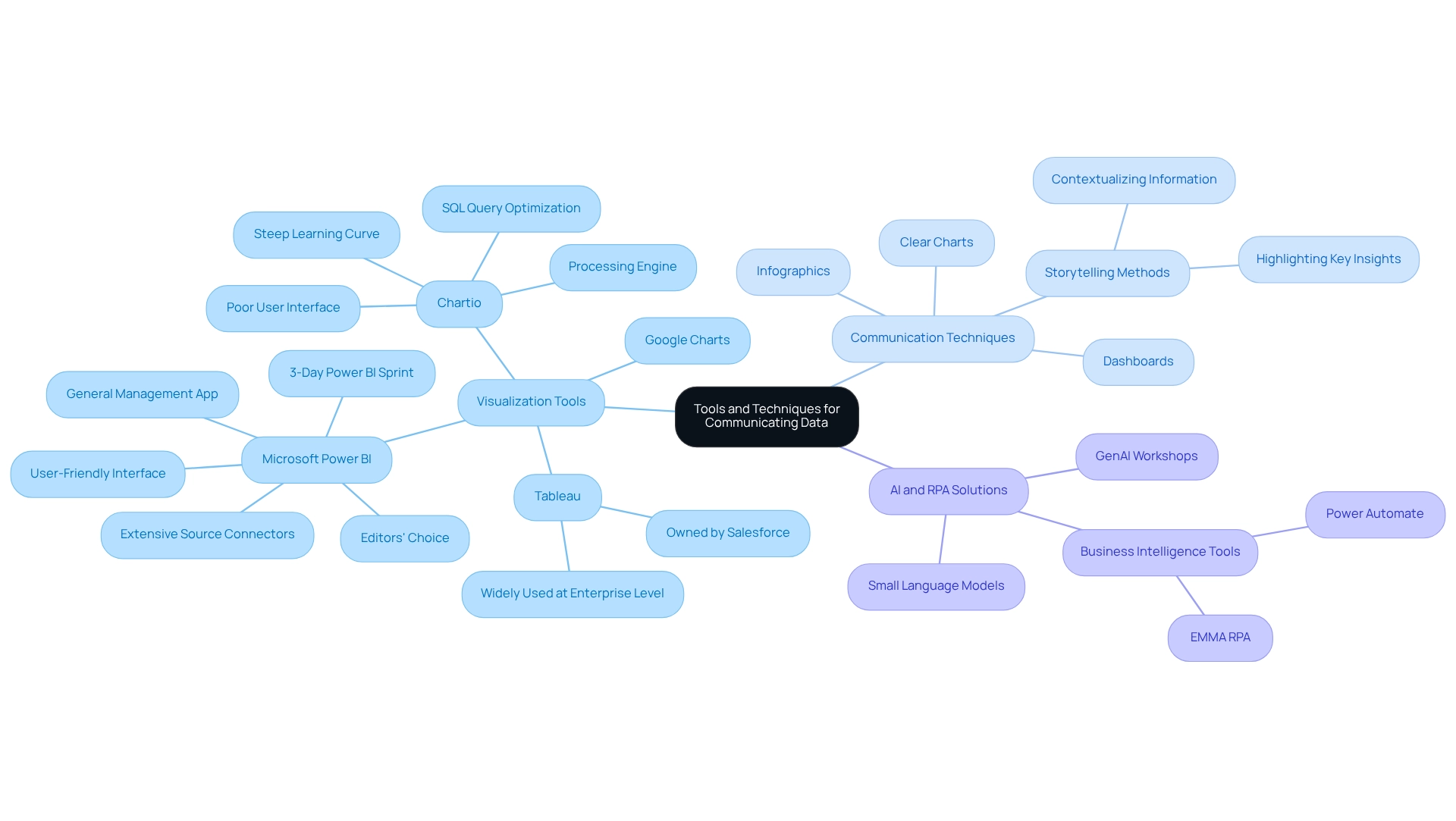
The Power of Storytelling in Data Communication
Storytelling serves as a transformative tool to communicate data in the field of information communication. By incorporating information within a narrative structure, presenters can create a captivating context that resonates deeply with their audience. This approach not only makes the information more relatable but also highlights essential insights and trends.
For instance, instead of merely showcasing statistics, a talented storyteller might demonstrate how those figures impact real people or lead to important business results. This narrative technique fosters emotional connections, significantly enhancing the audience’s ability to communicate data and understand the information presented.
The advantages of narrative in information exchange are significant. Research indicates that campaigns incorporating storytelling elements can increase engagement and funding, with video narratives receiving 114% more support than those without. This statistic emphasizes how storytelling can improve the effectiveness of information communication to better communicate data and make it more engaging.
Furthermore, a study reveals that pairing a story with a product can elevate its perceived value by an astonishing 2,706%. Such statistics highlight the effectiveness of storytelling in transforming information into a compelling narrative that captivates and informs.
Expert opinions consistently emphasize the importance of storytelling in improving information presentations. As noted by GO-Globe, “Storytelling holds real power. It helps build a genuine connection with your listeners, which is exactly what brands need to stand out, as data storytellers assert that narratives not only clarify complex information but also communicate data to foster closer relationships with stakeholders by ensuring a shared understanding of marketing results.”
For example, the transformative effect of Creatum GmbH’s Power BI Sprint service illustrates how impactful narrative presentation can enhance engagement and visibility, enabling businesses to connect with their clients on a deeper level.
To develop a compelling narrative using information, one must concentrate on constructing a tale that resonates with the listeners’ interests and requirements. Effective information storytelling involves choosing pertinent information points, contextualizing them within a relatable framework, and illustrating their implications through real-world examples. By taking this approach, companies can greatly enhance viewer interaction and promote informed decision-making, ultimately turning unrefined information into practical insights.
The success of Creatum’s Power BI Sprint, as emphasized by client feedback, demonstrates how such services can speed up information analysis and reporting, further improving operational efficiency and business growth. Creatum GmbH’s commitment to collaboration and creativity ensures that these solutions are tailored to meet the unique needs of the Director of Operations Efficiency, driving meaningful change in their organizations.
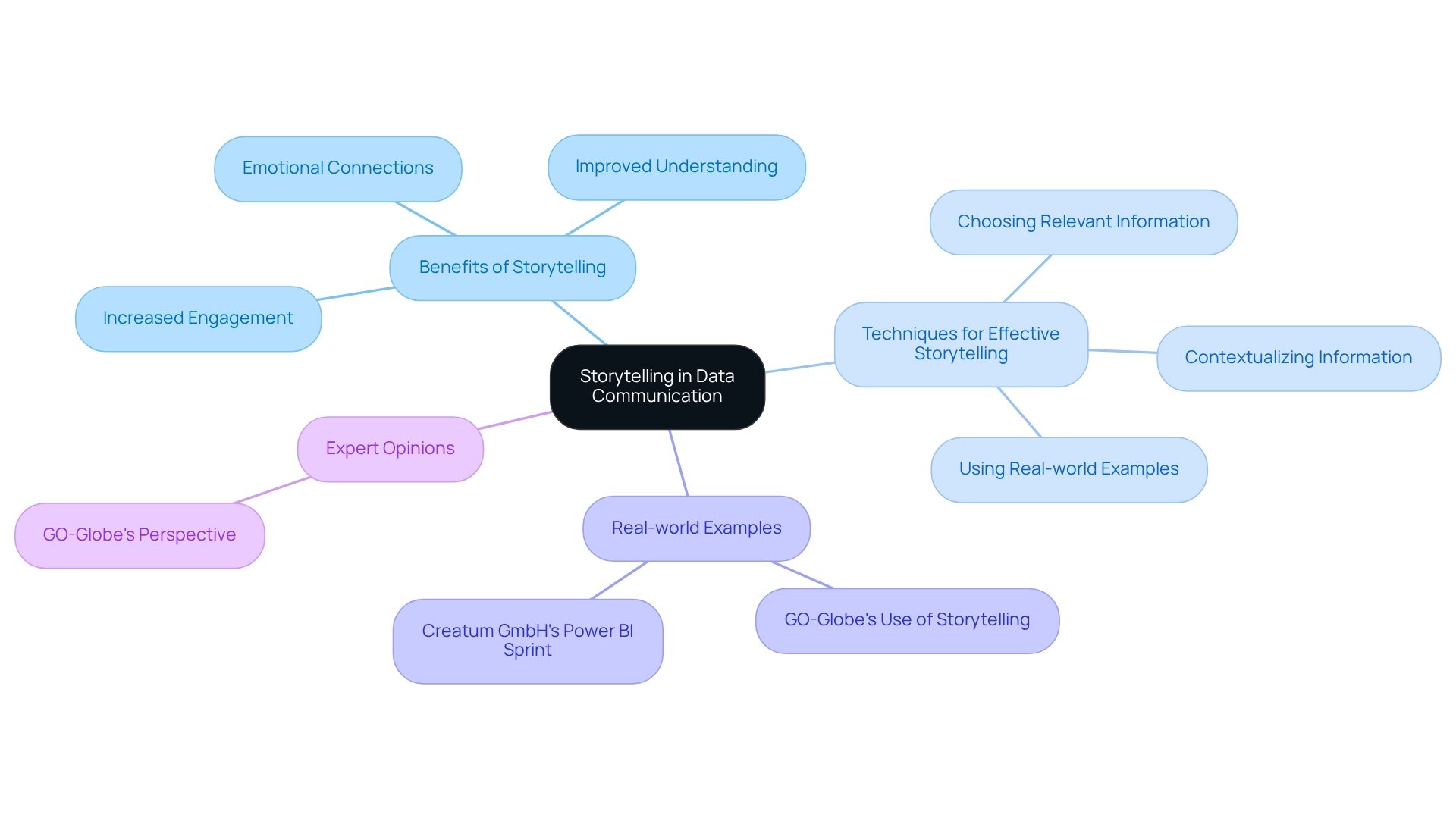
Tailoring Your Message for Different Audiences
Adapting your message for various groups is crucial for successful information exchange, particularly in the context of utilizing Robotic Process Automation (RPA) to improve operational efficiency. A profound comprehension of your viewers’ background, interests, and expertise allows you to present information in a way that connects with them. For instance, when addressing technical teams, exploring detailed analytics and in-depth metrics related to RPA implementations can reduce errors and free up teams for more strategic work.
Conversely, when engaging with executive stakeholders, a brief summary that emphasizes crucial insights and the transformative effect of RPA on business processes is frequently more effective.
Statistics indicate that 56% of customers feel frustration when asked to restate their information to various representatives, highlighting the significance of tailored interaction. This frustration can be alleviated by ensuring that information presentations are customized to the needs and expectations of the viewers, especially in a swiftly changing AI environment where it is vital to communicate data efficiently for operational success.
Strategies for personalizing information presentations include using language and examples that align with the viewers’ context. Technical groups may value jargon and particular information, while executive groups may favor more general trends and implications. Client testimonials from leaders like Herr Malte-Nils Hunold of NSB GROUP and Herr Sebastian Rusdorf of Hellmann Marine Solutions highlight how Creatum GmbH’s technology solutions have significantly enhanced operational efficiency and driven business growth through tailored RPA strategies and AI solutions that align with specific business goals.
A notable case study is Coca-Cola’s ‘Share a Coke’ campaign, which personalized product labels with popular names, creating a personal connection with consumers. This approach not only enhanced customer engagement but also significantly boosted sales and social media interaction, demonstrating the power of tailored messaging. This case illustrates how impactful information exchange can result in operational success by nurturing stronger relationships with customers.
Expert insights indicate that grasping the backgrounds of the listeners is essential in information sharing. By analyzing factors such as campaign source and customer behavior, marketers can personalize content effectively. This customization results in heightened loyalty, as devoted customers are five times more inclined to repurchase, five times more willing to forgive, four times more apt to refer, and seven times more inclined to try a new product or service.
In summary, effective communication strategies must adjust to the recipient’s technical or executive status to effectively communicate data that is pertinent and impactful. By employing these techniques, organizations can enhance engagement and drive better decision-making, ultimately contributing to improved operational efficiency and leveraging the full potential of RPA and business intelligence.
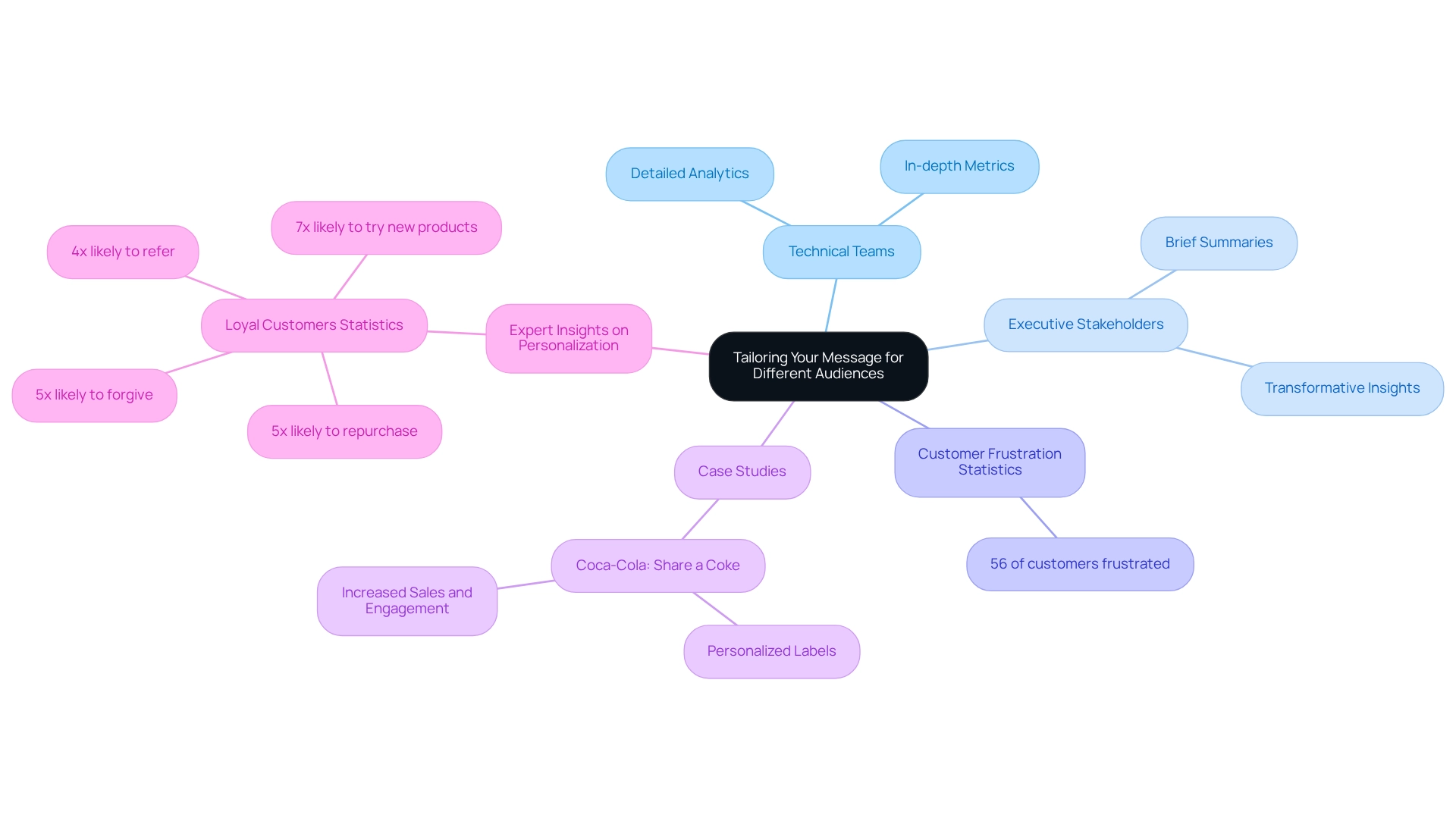
Effective Data Visualization Techniques
Effective information visualization techniques are essential for enhancing the clarity and impact of presentations. Selecting the right chart types forms a foundational step; for instance, bar charts are ideal for comparisons, while line graphs effectively illustrate trends over time. Thoughtful use of color can highlight key insights, yet it is crucial to avoid cluttered visuals that may confuse viewers.
Integrating interactive components into visual representations significantly enhances audience involvement, allowing viewers to examine information more meaningfully. This interactivity not only promotes exploration but also aids in directing the viewer’s comprehension of the displayed information. Best practices in information visualization emphasize the importance of accessibility.
For example, Smashing Magazine suggests that ’16 pixels should generally be the minimum size for body copy in modern web design,’ a crucial guideline for ensuring readability. Initiatives like LinkedIn Learning’s courses on accessibility in information visualization empower individuals to create inclusive visuals that cater to diverse audiences. This approach ensures that information is not only informative but also accessible to everyone.
Moreover, expert recommendations stress that the selection of chart type must align with the foundational question and information type. This reinforces that effective communication of information relies on careful design. As statistician Kaiser Fung illustrates through his annual Pi Day project, where he and his colleague transform poorly designed pie charts into more suitable formats, it serves as a reminder of the importance of clarity in information presentation. Ultimately, the goal of visualization is to simplify complex information to communicate data effectively, making it approachable and engaging for viewers, thus transforming raw content into practical insights.
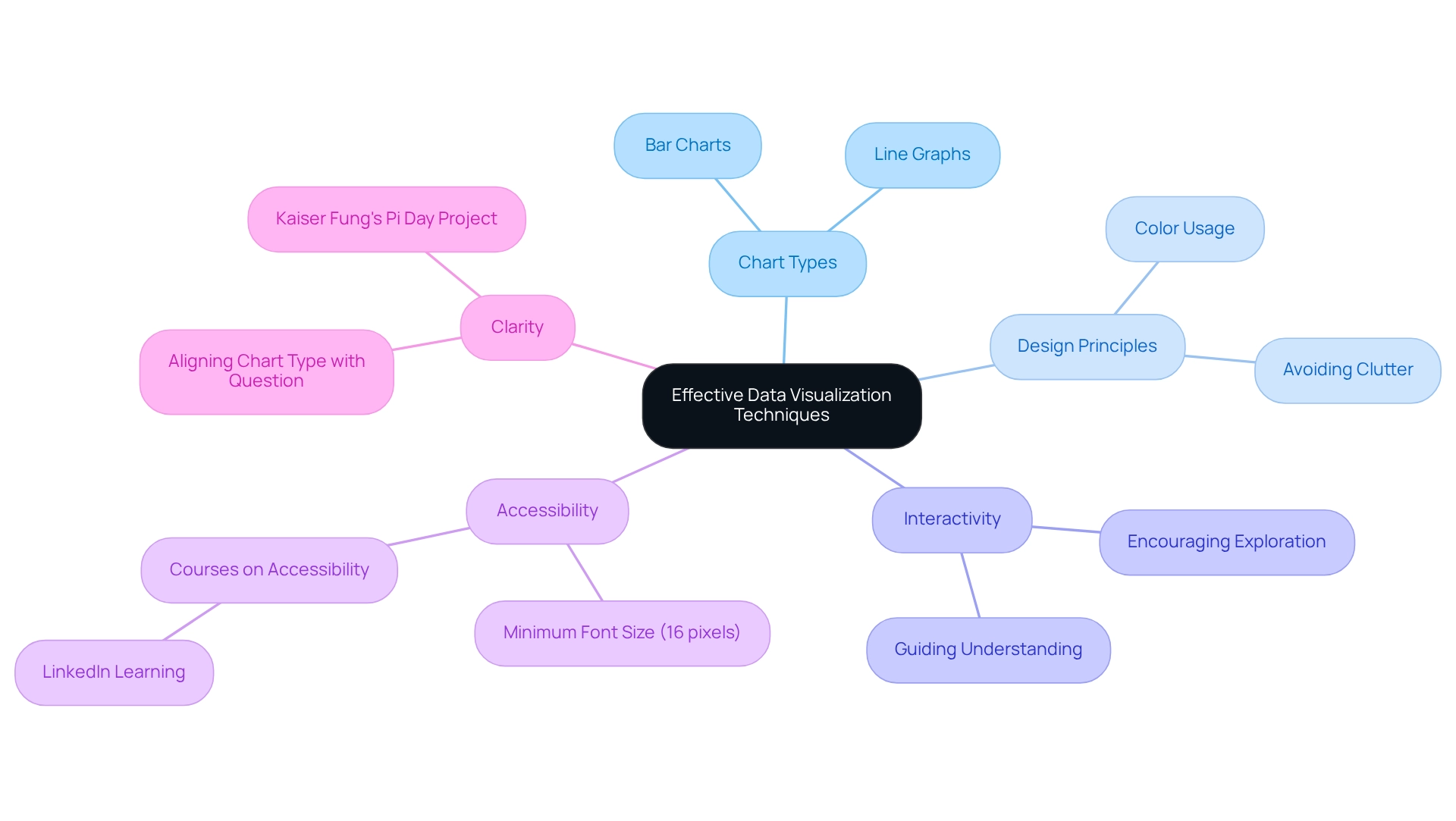
Common Pitfalls in Data Communication and How to Avoid Them
Effectively communicating data is crucial for ensuring insights are understood and actionable. Common pitfalls include overwhelming the audience with excessive information, using jargon that may alienate or confuse, and neglecting to provide necessary context for the information presented. Studies suggest that statistical traps like p-hacking, cherry-picking, and overfitting can occur in various areas, emphasizing the significance of meticulous information presentation to prevent misguided results.
To mitigate these issues, prioritize clarity and simplicity in your presentations:
- Limit the amount of information on each slide or visual to avoid cognitive overload. Information overload can lead to disengagement and misunderstanding, making it essential to distill complex information into digestible formats.
- Use plain language to enhance comprehension. Avoid technical jargon unless it is well understood by your listeners, as this can create barriers to effective communication.
Always clarify the importance of the information. Providing context helps the audience grasp the relevance of the information, enabling them to communicate data effectively and make informed decisions based on the insights shared. As Lisa Schwarz, Senior Director of Global Product Marketing, states, “By gathering and assessing information from various sources, analysts can assist leaders in recognizing patterns, evaluating key performance indicators (KPIs), and making evidence-based forecasts about future trends and outcomes.”
In today’s information-rich environment, utilizing Business Intelligence tools like Power BI can enhance this process, but challenges such as time-consuming report creation and inconsistencies must be addressed. Seeking feedback from peers can also be invaluable. Participating in open dialogue enables the recognition of aspects for enhancement in both expression style and content.
This collaborative method not only improves individual presentations but also nurtures a culture of ongoing enhancement in communication practices. Collaboration among professionals is encouraged to enhance development regarding the use of statistics.
Integrating automated validation checks and setting clear guidelines can further reduce formatting mistakes and ensure that the information presented is precise and trustworthy. The case study titled “Analysis Errors FAQs” emphasizes that successful evaluation requires quality controls and proper governance to avoid common challenges faced by analysts. By tackling these frequent obstacles, organizations can greatly enhance their strategies to communicate data, resulting in improved decision-making and increased operational efficiency through the effective use of Business Intelligence and RPA solutions like EMMA RPA and Power Automate.
To learn more about how Creatum GmbH can assist you, book a free consultation today.
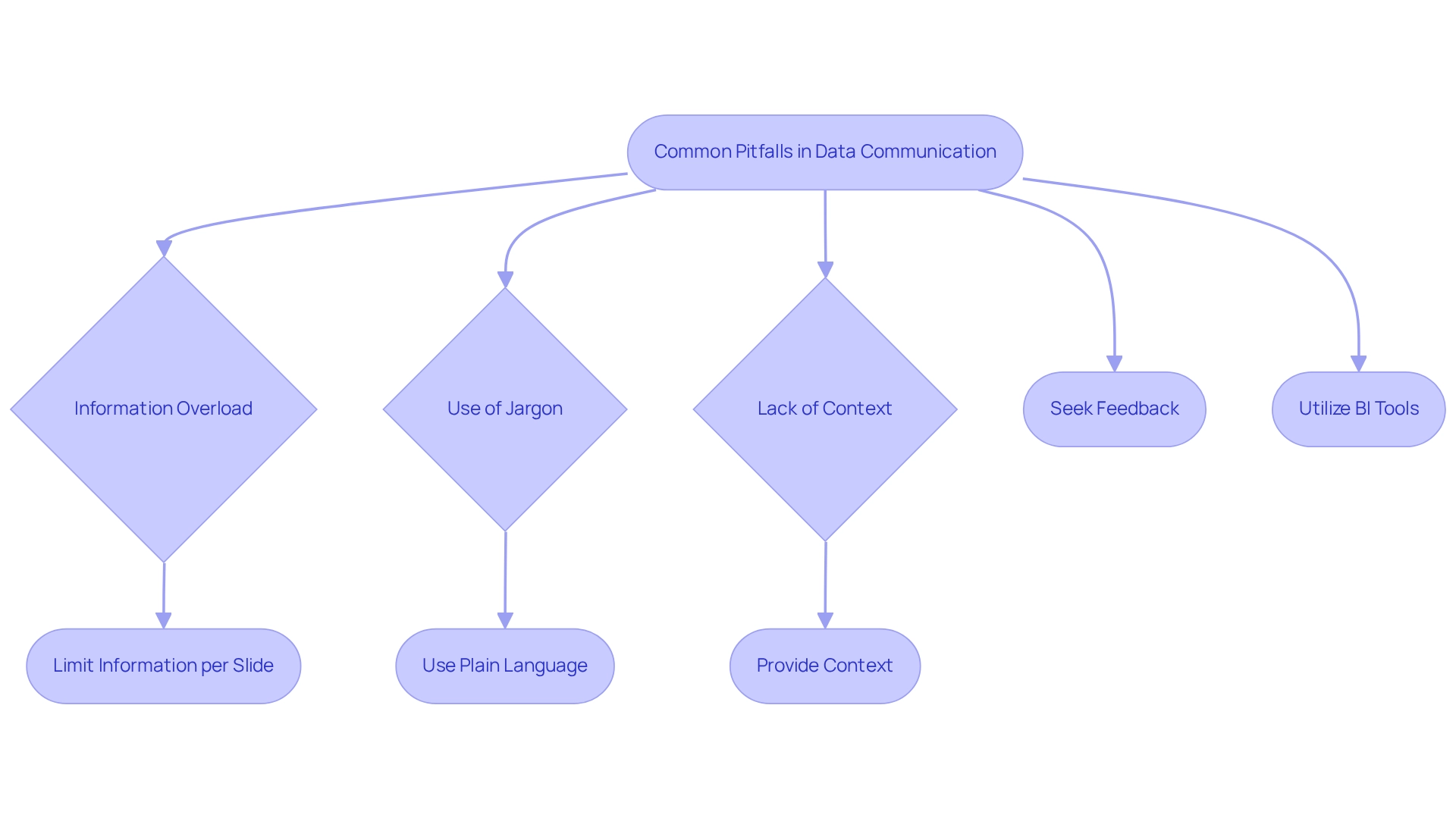
Continuous Improvement in Data Communication Skills
The ongoing enhancement of information exchange abilities is essential for sustaining significance in today’s rapid-paced environment. Regularly soliciting feedback from colleagues and stakeholders illuminates both strengths and areas for development. Engaging in workshops, webinars, and training sessions focused on communicating data and conveying ideas is vital; these opportunities not only improve skills but also foster a culture of learning.
Organizations emphasizing interaction training have reported a remarkable 40% rise in team creativity and innovation, underscoring the importance of effective dialogue. Additionally, with 75% of employees preferring visual aids over text-based communications, integrating visual elements can significantly enhance understanding and engagement.
Another key strategy is to practice your skills by presenting to diverse audiences and reflecting on their responses. This iterative process refines your approach, making you a more effective communicator. Experts in the field emphasize that feedback is vital for development; it offers perspectives that can lead to notable enhancements in how we communicate data.
Furthermore, case studies, such as those from AIrScreen, illustrate how detailed analytics can measure the effectiveness of communication strategies, enabling businesses to communicate data and optimize their methods based on data-driven decisions.
A powerful example is the experience of PALFINGER Tail Lifts GMBH, where the Power BI Sprint from Creatum not only provided an immediately deployable Power BI report and gateway setup but also significantly accelerated their own Power BI development. As Sascha Rudloff, Team Leader of IT and Process Management, observed, “The outcomes of the Sprint surpassed our expectations and served as a vital catalyst for our analytical strategy.” This underscores the significance of utilizing Business Intelligence tools, like those provided by Creatum, to effectively communicate data and convert raw information into actionable insights, ultimately fostering growth and innovation.
By committing to continuous improvement in their ability to communicate data, organizations can enhance operational efficiency and drive innovation.
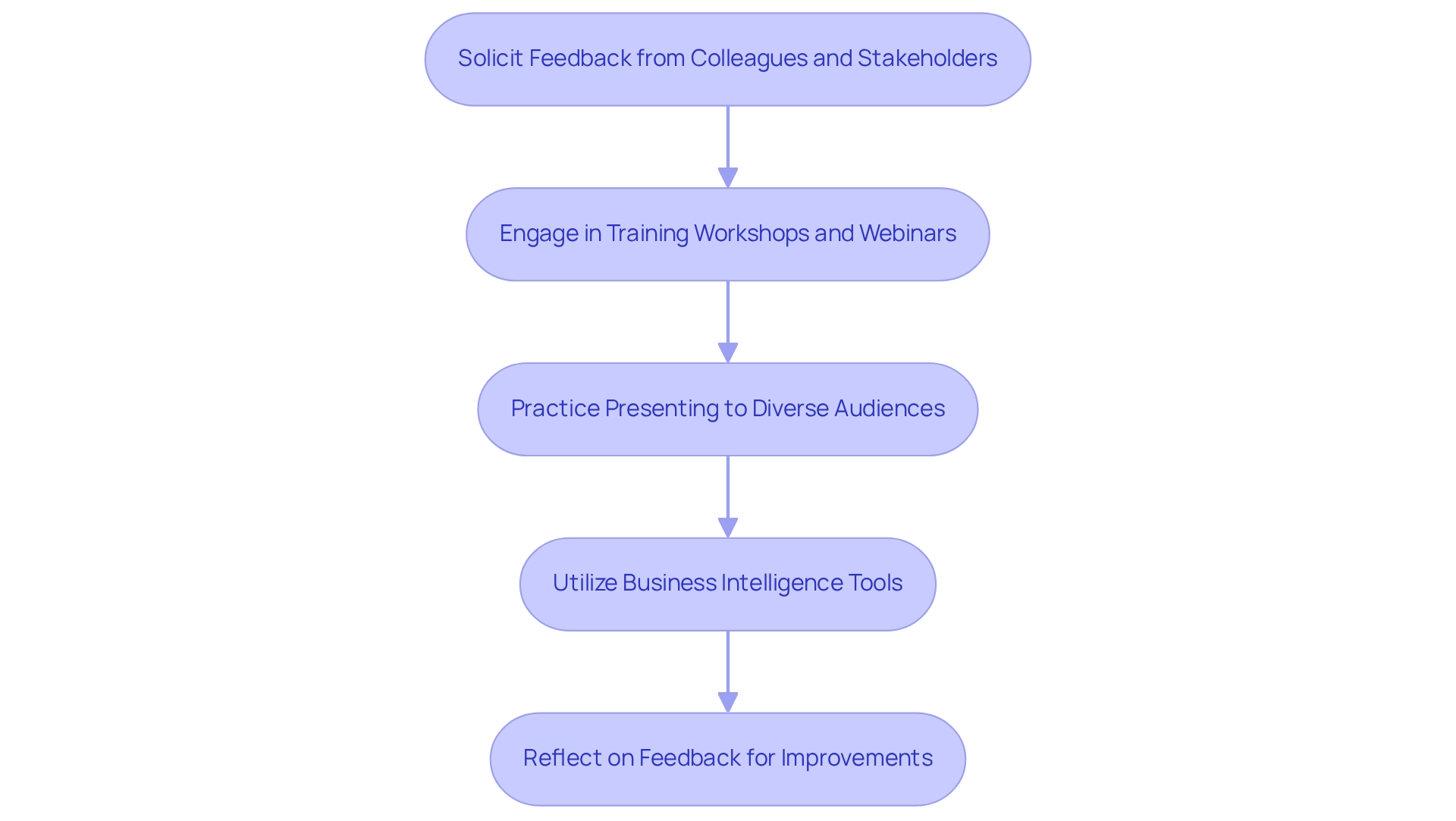
Conclusion
Effective data communication stands as a vital cornerstone for organizations striving to excel in today’s data-driven landscape. By grasping the fundamental components—sender, message, medium, and receiver—businesses can cultivate clearer exchanges and bolster operational efficiency. The integration of advanced tools like Microsoft Power BI, alongside the strategic use of storytelling, not only renders data more relatable but also significantly enhances audience engagement and comprehension.
Moreover, tailoring messages for specific audiences proves crucial. Acknowledging the differing needs of technical teams versus executive stakeholders paves the way for more impactful communication, ultimately steering informed decision-making. Steering clear of common pitfalls such as information overload and jargon is essential for crafting messages that resonate and uphold clarity. This dedication to clarity is further reinforced by implementing best practices in data visualization, transforming complex information into accessible insights.
Continuous improvement in data communication skills is paramount. By engaging in ongoing training and seeking feedback, organizations can refine their techniques and adapt to evolving communication needs. The case studies and statistics presented throughout the article illustrate that organizations prioritizing effective data communication not only enhance collaboration and innovation but also unlock significant growth opportunities.
In conclusion, mastering the art of data communication is not merely beneficial; it is essential for leveraging data as a strategic asset. By fostering a culture of effective communication, organizations can adeptly navigate the complexities of their environments, promote collaboration, and drive sustainable growth in an increasingly competitive landscape.
Frequently Asked Questions
What are the key components of data transmission?
The key components of data transmission are the sender, the message, the medium, and the receiver. Each element is essential for ensuring seamless interaction.
How does the sender initiate the data transmission process?
The sender initiates the process by transmitting a message through a selected medium, which can include wired connections, wireless signals, or other technologies, to the receiver.
Why is understanding data transmission components important?
Understanding these components is crucial for mastering information exchange across various contexts, such as formal reports and dynamic presentations.
What recent statistics highlight the importance of privacy in communication?
Recent statistics indicate that 98% of organizations report privacy metrics to their board of directors, and 70% of business experts note considerable benefits from privacy initiatives, which enhance operational efficiency and innovation.
How does effective privacy management impact customer trust?
Effective privacy management cultivates customer trust and aligns with organizational objectives, contributing to better decision-making and transparency.
What role does Robotic Process Automation (RPA) play in operational efficiency?
Employing RPA can streamline manual workflows, allowing organizations to automate repetitive tasks and reallocate resources toward more strategic initiatives.
How can tailored AI solutions assist organizations?
Tailored AI solutions, such as Small Language Models for information analysis and GenAI Workshops for training, help organizations navigate management challenges and improve decision-making capabilities.
What is the significance of effective information exchange in organizations?
Effective information exchange enhances understanding, facilitates informed decision-making, and fosters collaboration among stakeholders, while inadequate exchange can lead to misunderstandings and poor business decisions.
What impact does prioritizing efficient information exchange have on collaboration?
Organizations that prioritize efficient information exchange experience substantial enhancements in collaboration, with studies indicating a 25% rise in team productivity.
How can organizations leverage Business Intelligence for growth?
By prioritizing effective information exchange and leveraging Business Intelligence, organizations can unlock the full potential of their insights, leading to enhanced outcomes and sustained growth.

